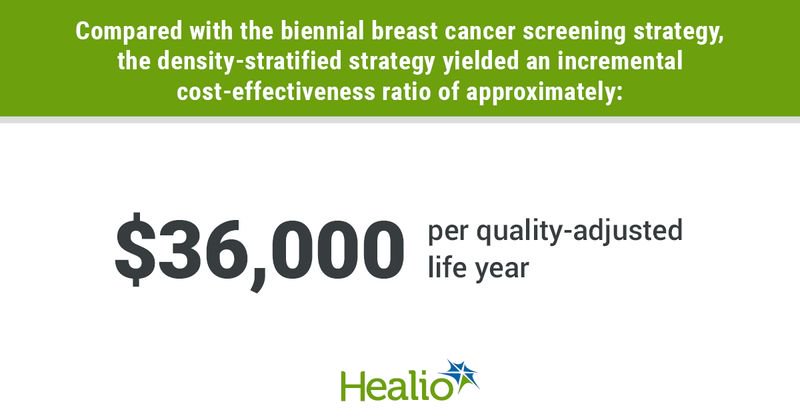Breast cancer screening strategy based on breast density at 40 years cost effective
A baseline breast density assessment in women aged 40 years followed by annual screening for those with dense breasts may be more cost effective than biennial screening starting at age 50 years, according to researchers.
“As we learn more about breast density and breast cancer risk, we wondered if it’d be beneficial for women to know about their density classification at an earlier age,” Ya‐Chen Tina Shih, PhD, section chief of cancer economics and policy at the University of Texas MD Anderson Cancer Center, told Healio Primary Care. “We addressed this question by conducting a modeling study to assess density‐stratified screening strategies.”

The model was based on a theoretical birth cohort of 500,000 women born in 1970 who had no known genetic risk factors or family history of the disease and a breast cancer incidence that matched age-specific incidence in 2017. It included different states of breast cancer disease: cancer free, asymptomatic or preclinical screening-detectable cancer, symptomatic or clinical cancer, and death due to either breast cancer or competing risks. Lifetime costs and quality-adjusted life-years (QALYs), discounted at 3% annually, were assessed in each of the following screening strategies:
- no screening;
- biennial or triennial mammography in women aged 50 to 75 years;
- annual mammography in women aged 50 to 75 years who were determined to have dense breasts at age 50 years and biennial or triennial mammography in women aged 50 to 75 years who did not have dense breasts at age 50 years; and
- annual mammography in women aged 40 to 75 years who were determined to have dense breasts at 40 years and biennial or triennial mammography in women aged 50 to 75 years who did not have dense breasts at 40 years.
Shih and colleagues reported that a base case analysis that considered the benefits and harms of screening showed baseline screening in women aged 40 years followed by annual screening at age 40 to 75 years for those with dense breasts and biennial screening at age 50 to 75 years for those without dense breasts was effective and cost effective. This analysis yielded a gradual cost-effectiveness ratio of $36,200 per QALY vs. the non-density-stratified biennial strategy at age 50 to 75 years.
The researchers also conducted a sensitivity analysis that “explored the effect of disutility associated with screening and diagnostic work-ups.” The analysis used a birth cohort from 1960, and “reduced the specificity of screening mammography by 8% to facilitate cross-model validation with similar studies published by the Cancer Intervention and Surveillance Modeling Network modeling group.” This analysis indicated that with a “societal willingness-to-pay” threshold of $100,000 per QALY, the likelihood of the density-stratified strategy at age 40 years being the “optimal” strategy was 56% compared with the other approaches.
According to the researchers, the base case analysis results “remained robust” in the sensitivity analyses and were “superior” to current recommendations by the U.S. Preventive Services Task Force and the United Kingdom’s National Health Service.

“The study is not meant to replace guidelines,” Shih said. “What we intended to achieve is to provide more information to physicians and patients as several guidelines leave screening decisions for women in their 40s to personal preference.”
In a related editorial, Karla Kerlikowske, MD, and Kirsten Bibbins-Domingo, PhD, MD, MAS, both of the epidemiology department at the University of California, San Francisco, cited data that indicate about one in four women with dense breasts are at high risk for a “missed invasive cancer within 1 year of a negative mammogram result.” They stressed that “not everyone with dense breasts is at increased risk for breast cancer,” and warned that screening women with dense breasts who do not have an increased risk for cancer “subjects them to more harms from false-positive tests, without additional benefit.”
“Thus, we caution against using breast density alone to determine if a woman is at elevated risk for breast cancer,” they wrote. “An attractive alternative is to focus on overall risk to select screening strategies, rather than just on breast density, because this approach better balances the benefits and harms of screening.”
References:
Kerlikowske K, Bibbins-Domingo K. Ann Intern Med. 2021;doi: 10.7326/M21-0398
Shih Y-C T, et al. Ann Intern Med. 2021;doi: 10.7326/M20-2912,
